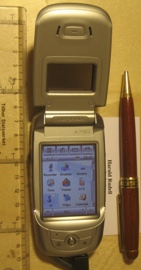James Ready | |
|---|---|
| Born | July 29, 1949 Danville, Illinois |
| Died | December 21, 2017 |
| Occupation | Founder and CTO of MontaVista Software |
James "Jim" Ready was a businessman and technologist. His company Montavista Software did pioneering work in adapting the operating system Linux for real-time applications. [1]
Ready received his BA from University of Illinois at Urbana-Champaign in 1971 and his MA from the University of California, Berkeley in 1976. [2]
Ready was founder and President of Hunter & Ready beginning in 1980, which merged with CardTools in 1986 to become Ready Systems. Ready Systems merged with Microtec Research in 1993, went public in 1994, and was acquired by Mentor Graphics in 1995. Ready served as chief technical officer at Microtec and Mentor [3] until he left in 1999 to found MontaVista Software. [4] Jim served as founder and CEO of MontaVista until June 5, 2006 when the role of CEO was taken over by Thomas F. Kelly. [5] Jim switched to the role of CTO of MontaVista. After the acquisition by Cavium Networks, Jim became CTO of MontaVista, now a wholly owned subsidiary. As of mid-2012, Jim was Chief Technology Advisor at Cadence Design Systems.

MIPS Technologies, Inc., formerly MIPS Computer Systems, Inc., was an American fabless semiconductor design company that is most widely known for developing the MIPS architecture and a series of RISC CPU chips based on it. MIPS provides processor architectures and cores for digital home, networking, embedded, Internet of things and mobile applications.
Mentor Graphics is a US-based electronic design automation (EDA) multinational corporation for electrical engineering and electronics, headquartered in Wilsonville, Oregon. Founded in 1981, the company was acquired by Siemens in 2017. Since 2021, the former Mentor Graphics operates as a division at Siemens named Siemens EDA.
An embedded operating system is an operating system for embedded computer systems. Embedded operating systems are computer systems designed for a specific purpose, to increase functionality and reliability for achieving a specific task. Resource efficiency comes at the cost of losing some functionality or granularity that larger computer operating systems provide, including functions which may not be used by the specialized applications they run. Depending on the method used for multitasking, this type of OS is frequently considered to be a real-time operating system, or RTOS. Embedded systems are mostly used as Real-time operating systems.
Versatile Real-Time Executive (VRTX) is a real-time operating system (RTOS) developed and marketed by the company Mentor Graphics. VRTX is suitable for both traditional board-based embedded systems and system on a chip (SoC) architectures. It has been superseded by the Nucleus RTOS.

Andrew Keith Paul Morton is an Australian software engineer, best known as one of the lead developers of the Linux kernel. He is currently a co-maintainer of the Ext3 file system, the journaling layer for block devices (JBD) and Memory Management.
OpenRISC is a project to develop a series of open-source hardware based central processing units (CPUs) on established reduced instruction set computer (RISC) principles. It includes an instruction set architecture (ISA) using an open-source license. It is the original flagship project of the OpenCores community.

MontaVista Software is a company that develops embedded Linux system software, development tools, and related software. Its products are made for other corporations developing embedded systems such as automotive electronics, communications equipment, mobile phones, and other electronic devices and infrastructure.

Robert M. Love is an American author, speaker, Google engineer, and open source software developer.
Wind River Systems, also known as Wind River, is an Alameda, California–based company. The company develops embedded system and cloud software consisting of real-time operating systems software, industry-specific software, simulation technology, development tools and middleware.
Operating systems based on the Linux kernel are used in embedded systems such as consumer electronics.
Carrier Grade Linux (CGL) is a set of specifications which detail standards of availability, scalability, manageability, and service response characteristics which must be met in order for Linux kernel-based operating system to be considered "carrier grade". The term is particularly applicable as telecom converges technically with data networks and commercial off-the-shelf commoditized components such as blade servers.
The ITRON project is the first of several sub-architectures of the TRON project.

The Motorola A780 is the second cellular PDA running the Linux operating system.
Stephen J. Mellor is a British computer scientist, developer of the Shlaer–Mellor method and Executable UML, and signatory to the Agile Manifesto.
Timesys Corporation is a company selling Linux open source software security, engineering services, and development tools, for the embedded software market. They also help software development teams build and maintain a custom Linux platform for embedded processors from integrated circuit manufacturers such as Atmel, Freescale, Intel, Texas Instruments, and Xilinx.
BitBake is a make-like build tool with the special focus of distributions and packages for embedded Linux cross compilation, although it is not limited to that. It is inspired by Portage, which is the package management system used by the Gentoo Linux distribution. BitBake existed for some time in the OpenEmbedded project until it was separated out into a standalone, maintained, distribution-independent tool. BitBake is co-maintained by the Yocto Project and the OpenEmbedded project.
LTTng is a system software package for correlated tracing of the Linux kernel, applications and libraries. The project was originated by Mathieu Desnoyers with an initial release in 2005. Its predecessor is the Linux Trace Toolkit.

Vishal Sikka is the Founder and CEO of Vianai, former CTO of SAP AG, and former CEO of Infosys. He currently also serves on Oracle's board of directors, the supervisory board of the BMW Group and as an advisor to the Stanford Institute of Human-Centered AI.